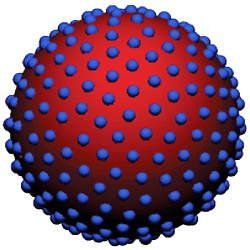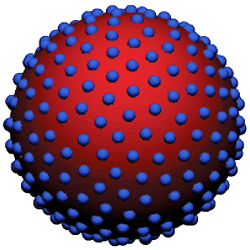Molecular Plasma is Cooler Than You Think
Plasma inside the sun blazes at millions of degrees, but much of the matter between the stars is also plasma, in a colder form. In the lab, cold plasmas have always been made from ionized atoms, but a team reports in the 14 November Physical Review Letters that molecules can also be turned into an ultracold plasma. They created the molecular plasma by cooling a beam of nitric oxide molecules and then hitting it with lasers. They say the technique can work for any molecule that can be vaporized. Ultracold molecular plasmas probably don’t exist in nature, yet they share characteristics with very dense plasmas in the centers of some stars and gaseous planets. On Earth they may be used to explore more complex plasma dynamics, or help researchers create even colder atomic plasmas.
Plasmas make up 99% of matter in the universe–mainly stars and gas clouds–yet they are less understood than the other three states of matter. They show up in astrophysics, fusion research, and technologies such as fluorescent lights and flat screen televisions. A plasma is an ionized gas, where some electrons have escaped from their atoms and roam freely about the cloud. If it’s very cold or very dense, the plasma is called strongly coupled–because the particles strongly interact with each other–and shares properties with the strongly coupled plasmas at the centers of white dwarf stars and giant planets.
In 1999 researchers created the first ultracold plasma [1]. Their technique involved cooling a cloud of atoms in a magneto-optical trap (MOT) before ionizing it. In the research flurry that followed, molecular plasmas were left out, because molecules can’t be cooled in a MOT.
Cold molecular plasmas could offer new insights into plasma dynamics, says Ed Grant of the University of British Columbia in Vancouver. The range of molecular combinations is far higher than the number of trappable elements, and molecules have more properties–such as orientation and internal vibrations–that could be used to probe complex plasma behavior. So he and his colleagues developed a system to make an ultracold molecular plasma and study it. “We’re trying to see what life is like for a molecule in a plasma,” says Grant.
The team used a standard technique to cool nitric oxide (NO) in a supersonic beam. As the cold molecules moved through a chamber, precisely tuned lasers bumped electrons on some of the molecules into highly excited (Rydberg) states, without raising the molecular temperature. Some of these excited electrons then gently slipped away from their orbits to make a plasma in the NO beam, with ions as cold as 1 degree Kelvin, and electrons as hot as 50 degrees Kelvin. These temperatures are as low as for the ultracold atomic plasmas, and to the team’s surprise, their plasma lasted just as long–up to 100 microseconds. Grant had expected electrons to combine with and dissociate the molecular ions more rapidly. The NO plasma was also 1000 times more dense than ultracold atomic plasmas.
The researchers also found that their molecular plasma experienced much less heating by a process called three-body recombination–where an ion and electron combine and send a second electron away at high speed–than is found with atomic plasmas. Understanding this difference could eventually help researchers create even colder atomic plasmas. The team says their method can be used with any atomic or molecular species that can be vaporized and offers a simpler method than a MOT for measuring the plasma size.
“Molecular plasmas offer far more possibilities than atomic plasmas. Your creativity palette for designing ultracold systems is greatly increased,” says Jan Michael Rost of the Max Planck Institute for the Physics of Complex Systems in Dresden, Germany. Rost is slightly skeptical of the work until he sees evidence from an independent team, but for now, he says, “The results look very positive.”
–Calla Cofield
Calla Cofield is an intern writer at APS.
References
- T. C. Killian et al., “Creation of an Ultracold Neutral Plasma,” Phys. Rev. Lett. 83, 4776 (1999)





